| Designation: | G6 |
 |
|---|---|---|
| Manufacturer: | LIW, a division of Denel (Pty) Ltd | |
| Product type: | Armoured Vehicles | |
| Name: | Self-propelled howitzer |
The G6 is a proven, high mobile, wheeled, rapidly deployable, self-propelled, 155mm 45 calibers howitzer. It does not require any additional truck for long range transport. Using Base Bleed projectiles the G6 has a range of 39 km, with Denel's V-LAP projectile the G6 the range is extended to 50 km. It features a direct fire capability at ranges of 3,000 m. G6 armor offers protection for the 6-man crew against small arms fire and shell splinters.
The G6 self-propelled howitzer carries 45 projectiles and 50 charges in the rear compartment with blow-off doors for increased safety. It is armed with a 7.62mm machine gun mounted on the turret roof for self-defense purposes. The G6 howitzer can fire all NATO 155mm ammunition and has a GPS navigation system to achieve improved accuracy.
The use of a wheeled chassis instead of the traditional tracked chassis, means more reliability, increased mobility, a low maintenance and life cycle costs, and an extended service life.
In the 1960s, the South African Artillery deployed three main artillery weapons, the UK 25-pounder Field Gun (G1), the 5.5-inch Medium Gun (G2) and the Canadian-built Sexton 25-pounder self-propelled gun.
During early South African operations in Angola the poor range of South African artillery compared to opposing Russian-supplied 122 mm D-30 and 130 mm M-46 towed artillery weapons and BM-21 122 mm (40-round) multiple rocket launchers led to the fielding of the Denel Land Systems 155 mm G5 gun-howitzer and the SOMCHEM 127 mm (24-round) Valkiri multiple rocket system.
While the towed G5 is perfect for many South African Artillery requirements, it does not have the cross-country mobility of the now BAE Systems Land Systems OMC Ratel (6 × 6) infantry vehicle which has been in service since 1976.
The South Africans weighed the options of wheels or tracks for their new self-propelled artillery system and came down firmly in favour of wheels. The possible areas of operation of the G6 are likely to be some distance from their main bases, perhaps up to 1,000 km, and tracked vehicles have distinct disadvantages over long distances. Fuel consumption of a wheeled vehicle is a lot less than a tracked vehicle so less logistic support is required. The decision was therefore taken to choose a wheeled artillery system.
The G6 prototype was completed in 1981 and shown for the first time in public in September 1982. By late 1986, four complete G6s had been built plus one additional turret. Of these four, two were considered as prototypes and two advanced development vehicles, for they incorporated many improvements as the result of user trials and changes in operational requirements.
The first advanced development vehicle was completed early in 1984 and the second during 1986.
There were four engineering development models completed during 1987 for final troop trials and confirmation of the modifications carried out on earlier vehicles.
The first production G6s were completed during 1988, with Denel Land Systems being the prime contractor. BAE Systems Land Systems OMC delivers the chassis to Denel Land Systems which integrates the turret and delivers the complete system to the user.
The production G6s were the first self-propelled howitzers with a full autonomous laying and navigation capability.
As with the earlier G5, the G6 is a complete system and includes not only the vehicle but also the ammunition system, meteorological station, muzzle velocity analyser, fire-control system and a special artillery helmet radio communication system. Some of these systems have been in production for the G5 155 mm/45 calibre towed for some years. This support equipment is continuously upgraded or replaced by improved products.
The G6 is deployed in batteries of six with the South African Artillery, each regiment having three batteries.
In 1990, Abu Dhabi, part of the United Arab Emirates, placed an order for the supply of 78 G6 155 mm self-propelled howitzers with the first of these being delivered early in 1991. All have now been delivered and are organised into three regiments each of 24 weapons, with the remaining vehicles being used for training and war reserve. A comprehensive long-term product support package was also successfully delivered and implemented.
Early in 1994, Oman placed an order for 24 G6 155 mm self-propelled howitzers, spares, logistic support, ammunition and a training package. All have now been delivered to Oman.
Late in 1996, it was disclosed that the South African National Defence Force had a total of 43 G6 systems in service under the designation GV6.
The hull of the G6 is all-welded steel armour, with protection against a variety of threats including small arms fire and shell splinters. The G6 has a double armoured floor for increased protection against anti-tank mines.
The chassis is essentially divided into three compartments, driver at the front, power pack in the centre and fighting compartment at the rear.
The driver sits at the front between the front two roadwheels and, as there is no hull armour above these, any blast resulting from the vehicle running over a mine will be vented upwards and away from the driver.
To the front and sides of the driver are large bullet-proof windows which afford excellent visibility through the front in excess of 180°. If required, the central front window can be covered by an armoured shutter, hinged at the bottom, simply by activating a lever. When this is raised the driver observes through a periscope. The driver enters and leaves the vehicle via a roof hatch that opens to the left. Communication between the driver and the gun crew is via the gun's intercom system.
Steering is power assisted and the G6 now has permanent 6 × 6 drive (prototypes had the option of 6 × 4 with the front axle being disengaged). The driver can select either fully automatic or semi-automatic drive.
Forward of the driver's compartment is a lateral wedge-shaped box that doubles as a container for projectiles and as a bush-clearing device capable of cutting through trees and shrubs.
The diesel engine compartment is to the rear of the driver's position with air inlet louvres in the front of the engine venting through the roof and the air outlet louvres through the sides, all of which can be opened to allow access to the engine for maintenance. The engine compartment is fitted with a fire detection and suppression system.
The G6 is powered by an air-cooled diesel developing 518 hp, it is coupled to an automatic transmission with a torque converter giving a total of six speeds forward and one in reverse.
Drive shafts take the power from the transmission via differentials to each roadwheel station.
The crew compartment, with the turret above, has seats for the commander, gun layer/navigator, breech operator, loader and an ammunition handler. There is an escape hatch in the floor. The turret crew enter via the main door in the rear right-hand side of the turret or via two roof hatches in the turret, one either side.
The fully enclosed armoured steel turret has firing ports either side, with vision blocks above for close-in defence. Standard rifles and grenades are carried for close defence.
Mounted either side of the forward part of the turret is a bank of four 81 mm electrically operated grenade launchers which fire smoke grenades.
The gun commander sits at the right front of the crew compartment. A Gun Management System (GMS) is provided to assist the commander with command, control, communication and information functions in and around the G6. The GMS contains a Gun Display Unit (GDU) situated at the commander station which is used for sorting and displaying navigation data, gunlaying data and fire orders received via radio data communication link to each G6 from a Battery Command Post (BCP). Data transmission is also performed when the gun is mobile, ensuring an in action time of 1 minute and out of action time of 30 seconds.
Navigation and gunlaying data is transmitted via serial communication to the Laying and Navigation System (LNS). Navigation data contains UTM map datum points, routes containing waypoints and danger points with selectable warning radii. The GMS interfaces with a Muzzle Velocity Radar System (MVRS). The MVRS, which is mounted above the rear part of the 155 mm ordnance, calculates a predicted mean normalised muzzle velocity. This calculated value is obtained utilising a moving average of muzzle velocities of an already fired group of ammunition. This value is used during target laying data calculations.
The GMS also interfaces with a Thermal Warning Device (TWD) warning the crew of unsafe barrel and recoil oil temperatures. Digital and analogue values are displayed on a separate TWD display by the commander. The TWD is connected to the intercom system providing an audible warning. A barrel-cooling fan is provided to reduce recovery time in the event of unsafe temperatures being reached.
The GMS contains an Ammunition Display Unit (ADU) mounted on the left rear of the vehicle providing the ammunition replenishment crew outside the gun with ammunition preparation and gunlaying data ensuring silent operation on the deployment site.
Data transmission makes use of the UHF/VHF frequency-hopping system of up to 50 km in range or back-up voice UHF radio link of up to 10 km in range. The commander in turn is in constant communication with the crew of the gun by using an internal intercom system or external local VHF band system of up to 100 m in range with the crew carrying belt-mounted transceivers.
Safety during firing is ensured with the aid of firing safety interlocks. The gun can only be fired once the breech operator, gun leader and gun layer have depressed their safety/ready switches and the gun has been laid within 1 mil onto target.
The gun layer/navigator sits at the left front of the crew compartment.
A Laying and Navigation System (LNS) assists the gun layer with laying and navigation functions. The LNS, using an RLG (Ring Laser Gyro) inertial unit, provides an autonomous all-weather day and night fighting capability from unsurveyed sites with all time ready state navigation and gun orientation ability. Navigation and gun orientation is performed without the use of external reference points or signals.
An additional Fibre Optic Gyro (FOG) inertial unit can be provided as an option giving a full laying and navigation back-up capability ensuring continuous availability of the gun.
Both the RLG and FOG inertial units receive inputs from a Distance Transmitting Unit (DTU) mounted on the gearbox of the vehicle. An additional embedded Global Positioning System (GPS) input complements the navigation accuracy. Advanced filtering techniques are used to optimise gunlaying and navigation performance.
Navigation information and centre of arc is displayed for the driver ensuring orientation of the gun during deployment.
The LNS requires no scheduled service or recalibration during operation and no scheduled maintenance during storage of the gun. Cold start is reduced to 12 minutes for both inertial systems. The Mean Time Between Failures (MTBF) of the RLG inertial sensor is 7,000 hours compared to 1,000 hours of the previous mechanical gyro system used in previous models.
A fully automatic gunlaying capability in both traverse and elevation directions is provided. This automatic gunlaying system enables rapid and accurate relaying of the 155 mm ordnance between rounds at high rates of fire. Accurate gunlaying is activated by a single touch button on the laying and navigation touchscreen. Target data is downloaded with the data communication link from the BCP via radio to the GMS in the gun. The GMS in turn downloads the target data to the LNS ensuring ease of operation. Target data can also be keyed into the LNS via the touchscreen display.
Direct firing is done by the gun layer under the commander's command. A telescopic direct sight is provided for initial aiming onto a direct target by the gun layer. Automatic onboard calculations are done by the LNS utilising direct firing range tables. A laser range-finder is integrated with the LNS to provide instant target range. The ordnance is aimed automatically on target utilising a single touch button on the laying and navigation touchscreen.
The 155 mm 45 calibre autofrettaged ordnance of the G6 is a modified version of that used in the towed G5. It has a single-baffle muzzle brake, a semi-automatic screw and swing breech mechanism and an electrical firing system. A steel fume extractor is fitted. The recoil system consists of a single buffer and single recuperator.
The turret can be traversed through 180° (90° left and right) under electrohydraulic control with manual controls provided for maintenance, although for practical purposes the firing arc of the turret is 40° left and right. The 155 mm ordnance can be elevated from -5 to +75° under electrohydraulic servo control.
Although a single-touch auto layer provides the main laying function, a digital hand controller is provided for manual elevating and traversing the ordnance. A Hydraulic Control Panel (HCP) provides hydraulic system status. The HCP also has a joystick providing additional back-up for traversing and elevating the ordnance during emergency conditions or during maintenance.
A semi-automatic hydraulic flick rammer is mounted on the left of the breech with the projectile being placed on the rammer tray by hand. This is then aligned with the breech and rammed. The rammer can be used at all elevation angles and is operated by the ammunition loader. Propelling charges are loaded directly into the breech by hand by the breech operator.
A rate of 4 rds/min is achieved when firing with the maximum charge and can be continued for a period of 15 minutes, after which chamber temperatures have to be monitored. A rate of 5 rds/min is achieved when firing charge 2. A burst capability of 3 rounds in 25 seconds can be obtained.
The 155 mm ammunition used with the G5 and G6 is of the ERFB type. Rounds available include HE, Smoke, Illuminating, RP, Submunition and Leaflet. The HE projectiles are forged from A151 9260 high-fragmentation steel with welded nubs. Filling may be TNH at the choice of the customer. The cargo rounds mentioned above are of the base ejection type.
The Illuminating projectile has 1,000,000 candela for 120 seconds while the Smoke (SCR SMK) produces a smoke screen for 120 seconds from four canisters. The submunition round contains 42 bomblets and has an anti-personnel as well as a 120 mm armour-piercing capability. This round is sometimes referred to as the Cluster.
The charge system comprises five zones made up of three charges (combustible cartridge cases) and is optimised for use with 155 mm 45 calibre ballistic systems.
The fuzes used with the projectiles include the PD M841, the M9220 electronic time fuze and the M8513 proximity. The PD M841 and M8513 are used with HE. The M9220 is used with Smoke, Illuminating, RP, Submunition and Leaflet. The PD M841 fuze incorporates a rain/cloud desensitising device to replace the US PD M572/PD M739 fuze and is compatible with base bleed projectiles.
At 75 per cent of maximum range, the 50 per cent zone for dispersion (2PE) is 0.96 per cent of range in length and less than 2 mils in deflection.
All 155 mm projectiles and charges are stowed below the turret bearing ring. It takes three men 15 minutes to reload the G6 with 45 projectiles and 50 charges. Fuzed projectiles and charges are transferred from an ammunition support vehicle through the rear of the G6 on conveyor chutes.
The G6 can be fired from the wheels, but is more stable when the four outriggers are lowered hydraulically to the ground by the driver or commander, two at the rear and one between the first and second wheels either side.
The crew compartment is provided with an explosion detection and suppression system with four outlets for the suppressant around the turret. Blowout panels are provided in the hull rear and the stowage of all ammunition is below the turret to improve the survivability.
The driver's compartment is provided with forced ventilation with the option of air conditioning, while the crew compartment has full air conditioning. Temperatures of 25°C lower than ambient can be maintained at ambient temperatures of up to 55°C.
A 38 kW Turret Power Unit (TPU) is mounted in the turret bustle to charge batteries and drive the air conditioning system. The latter is fitted with an NBC filtration system functioning on an overpressure principle.
The production G6 has permanent 6 × 6 drive and diff-locks on all differentials for improved traction. It is fitted with a central tyre-pressure regulation system that enables the driver to adjust the tyre pressure to suit the type of terrain while on the move.
The G6 has an independent suspension with torsion bars, hydraulic shock-absorbers and bump stops all-round. The 21.00 × 25 tyres are fitted with run-flat elements.
The G6 is supported in action by an ammunition supply vehicle carrying 156 rounds in four ammunition units and support equipment.
The turret and driver air conditioning systems of the G6 have been upgraded to accommodate ozone friendly R134a refrigerant gas. Halon gas in the fire extinguishing system has been replaced by NAF Slll gas, these being ozone friendly products.
- 155 mm T6 turret
This was developed for the Indian Army competition for a 155 mm turret system that could be fitted onto the chassis of the locally built T-72M1 chassis. It forms the basis for the latest Denel Land Systems G6-52 155 mm self-propelled artillery system that was launched in 2003. Details of this are given in a separate entry. The T6 turret has been demonstrated in a number of countries but as of late 2007 it remained at the prototype stage.
- More range for G6
In 2001, Denel Land Systems announced that their 155 mm G6/45 calibre self-propelled artillery system could now fire accurately out to a range of 53.6 km.
According to the company, this makes the G6 the first fully qualified and in-service 155 mm/45 G5 gun and ammunition system breaching the 40 km range barrier by a considerable margin.
The 53.6 km range was achieved using the new Velocity enhanced Long range Artillery Projectile VLAP, which combines base bleed and rocket motor technology and the new M64 bi-modular charge system. The latter has also been fully qualified and is in quantity production for export. The new charge gives a maximum muzzle velocity of 910 m/s.
During extensive qualification firings in South Africa from a G6, probable errors in ranges were constantly better than 0.38 per cent. To make space for the base bleed and rocket assist elements, the VLAP carries less high explosive. Its lethality is however still considerably higher than the older 155 mm M107 high-explosive projectile.
The VLAP can be used with the 155 mm G5 towed and G6 self-propelled artillery systems and has already entered production for use with an undisclosed export customer equipped with the G6 system. It is probable that the country concerned is the United Arab Emirates (UAE).
- PRO-RAM projectile
In 2001, it was disclosed that South Africa was working on yet another new 155 mm long-range artillery projectile called the PROjectile RAM (PRO-RAM). This has an integrated ramjet propulsion system and will allow ranges of at least 70 km to be achieved. It will also be very accurate when fitted with a low-cost course correction module.
- Extended-range G5 and G6
Late in 1992, it was revealed that the company had built the prototype of a 155 mm ordnance with a calibre length of 52. It was used in development work which could be used to upgrade the G5 and G6 in the future, enabling their range advantage to be retained.
A number of developments is also under way on 155 mm ammunition in South Africa to give the user greater operational flexibility. Now available is the new M90 bi-modular charge system comprising identical modules of around 2.2 kg which can be used in 39, 45 and 52 calibre systems. A new 155 mm high-explosive Extended-Range Full-Bore - Base Bleed (ERFB-BB) projectile has been developed, containing 8.4 kg of high explosive which gives a range of 41 km. When fired from a 155 mm 52 calibre ordnance a range of 43.5 km is achieved.
The base bleed unit is of the screw-on type and can be removed under field conditions if not required.
More recently, the Velocity-enhanced Long-range Artillery Projectile (VLAP) has been introduced which is a rocket motor-assisted 155 mm projectile combined with the base bleed unit. This extends the range of the 45 calibre G5, G6 and T6 systems to 50 km and the 52 calibre gun to 52.5 km.
- UAE G6/M109L47 upgrade
The United Arab Emirates awarded Denel Land Systems a contract to upgrade their G6 and RDM Technology M109L47 to a common gunlaying and navigation integral fire-control system. It should be noted that RDM Technology ceased trading in 2004.
- 155 mm GV6
In 1996, it was stated that the first upgraded and retrofitted GV6 had been delivered to the South African Army. It is not known at present what this upgrade includes.
- G6 M1A3
This is the latest model of the G6, which is being marketed in the Middle East. This retains the 155 mm/45 calibre barrel with a 1:20 twist rifling and 48 grooves 1.27 mm deep, which are common to 155 mm 39 and 52 calibre tubes that meet the NATO Joint Ballistic Memorandum of Understanding, as well as a 23 litre chamber.
The original glass fibre fume extractor has been replaced by a new steel fume extractor. Additional safety interlocks have been installed, as has an improved rammer, to increase rate of fire from 3 to 5 rds/min.
The Somchem M64 bi-modular charge system and the ERFB-BB give a maximum range of 40.5 km. Firing the latest VLAP, a range of 53.6 km can be achieved.
It also fitted with the latest AS2000 fire-control system to give a four round MRSI capability. The commander has an African Defence Systems launcher management computer with a Windows based touch screen, while the gunner has a Denel WM205 gun data display and a new digital hand controller. The Selex Sensors and Airborne Systems FIN3110 RLG and integrated GPS sensor is retained.
The chassis has been fitted with a three-level central tyre pressure regulation system. Other enhancements include a more powerful turret APU, improved insulation and a cool water dispenser.
As well as featuring improved reliability, these upgraded systems were also fitted with barrel temperature measurement, a barrel cooling fan on the cradle, improved air conditioning system and a backup laying system.
|
||||||||||||||||||||||||||||||||||
|
|||||||||
|
||||||||||||||||||
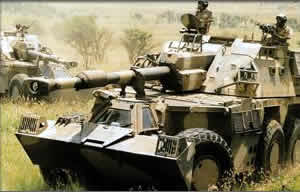 |
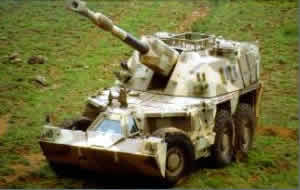 |
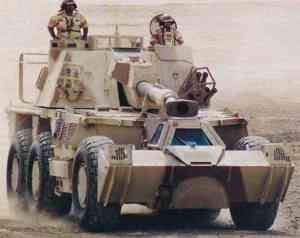 |
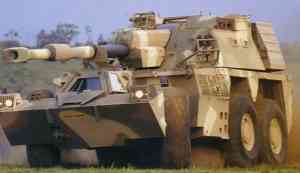 |
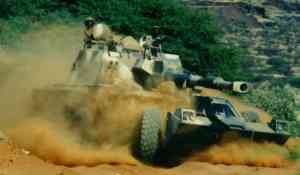 |
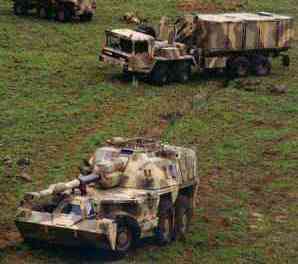 |
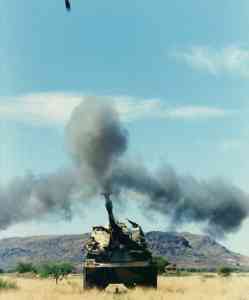 |
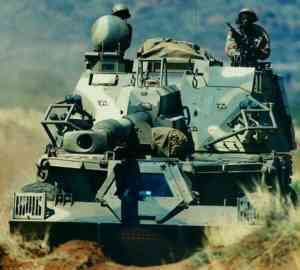 |
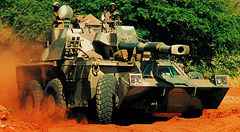 |



